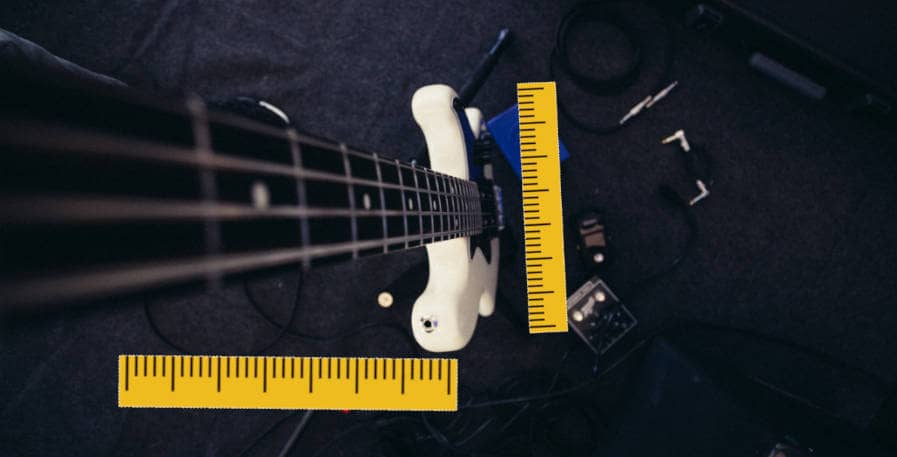Whether you are a complete beginner or an intermediate bassist, it is beneficial to have some knowledge of the dimensions of a bass guitar.
This is because they affect how the instrument feels to play, and whether it will fit your style and physiology.
Therefore, I decided to make this list of everything you need to know about the dimensions of a bass guitar.
We`ll start off by covering what the common dimensions of a bass are, and how these differ depending on scale length and the number of strings. I will also cover the pros and cons of small vs big basses.
Lastly, I`ll talk about some less obvious dimensions of the bass. These include nut width, radius, weight, and neck thickness. Then, I will show you how these dimensions are measured and why they are important to you as a bass player.
This way, you will know exactly what to look for in a bass guitar, which makes it much easier to find the perfect instrument for you.
How big is a full-size bass?
Full-size 4-string bass guitars are approximately 46″ or 118cm long, 12″ or 30cm wide, and 2.5″ or 6cm deep. 5 and 6-string bass guitars are slightly longer on average but do not noticeably differ from 4-strings in width and depth. Short-scale basses are also similar in width and depth but can be noticeably shorter.
While bass guitars differ in size, most long-scale basses tend to have similar dimensions.
Thus, while every individual model will have its slight differences, they will not deviate greatly from these dimensions.
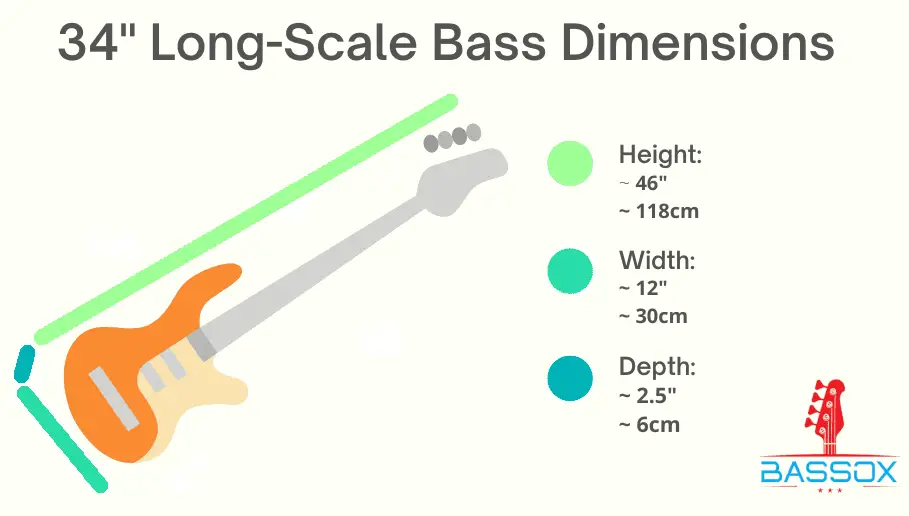
While 5 and 6-string basses can be slightly longer. Oftentimes though, they have a scale length of 34″ inches like most 4-strings, and thus also have a similar length.
Short-scale basses are a different breed and are notably shorter. As scale length correlates to the overall length of a bass, let`s continue by examining what it is, and how it differs from the full length.
Scale Length
Bass guitars are most commonly measured in scale length. Scale length measures the distance between the nut and the bridge of the bass. As the strings are anchored to these two components, scale length also measures the length of the playable strings.
Thus, when people talk about the length of a bass, they are generally not talking about the full length of the instrument.
The full length of a bass guitar is generally between 1.15 and 1.20 times that of its scale length. This extra length comes from the headstock and the space below the bridge saddle of the bass.
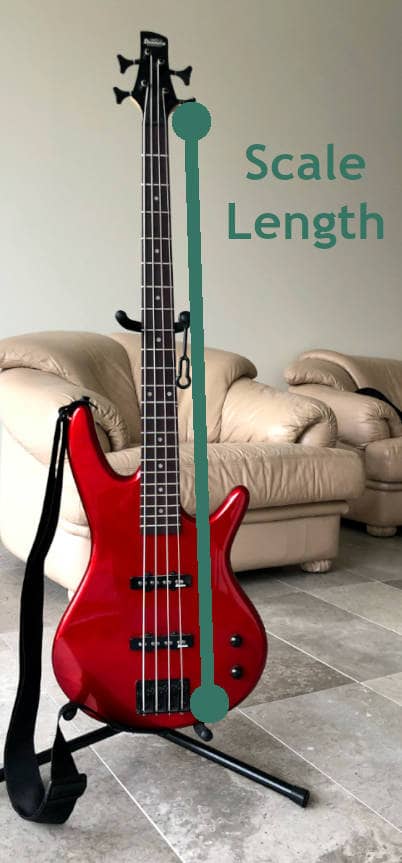
This is helpful to know, as online retailers will often not list the full dimensions of a bass guitar. You can, however, use the scale length to get an approximate idea about the length of a bass.
Scale-length is not a unique metric to the bass and is also used for violins, guitars, and ukuleles. We use scale length instead of total length because it has a bigger impact on what the instrument will actually feel like playing.
Bass dimensions and scale length
Bass guitars come in different sizes, with the long-scale, and short-scale bass being the most common types. There are also medium-scale basses and extra long-scale basses, as well as extra small short-scale basses intended for children who are still growing.
Extra long-scale basses most commonly have 5 or 6 strings. Long-scale basses have 4, 5, and 6 -strings, whereas smaller models usually only have 4 strings, and sometimes 5.
Bass guitars of different scale lengths only differ slightly in depth and width. However, the total length of a bass can change quite a bit. Here is an overview of the approximate dimensions you can expect from basses of different scale lengths:
| Bass guitar type: | Scale length: | Approximate dimensions: |
| Extra-long scale | 35″+ (Commonly 35″) | 124 cm x 33cm x 7.5cm (49″ x 13″ x 3″) |
| Long-scale | 34″ | 118cm x 30cm x 6cm (46″ x 12″ x 2.5″) |
| Medium-scale | 32″ | 109cm x 30cm x 6cm (43″ x 12″ x 2.5″) |
| Short-scale | 31″- (Commonly 28.6″ or 30″) | 99cm x 29cm x 5.8cm (39″ x 11″ x 2.5″) |
Bass Width
Most bass guitars are between 11″ and 14″ (28cm to 35.5cm) in width. We get this number from measuring the body of the bass between its two widest points.
Basses with a short scale length have on average slightly narrower bodies than ones with a longer scale length. However, the width of the bass is more dependent on the manufacturer, and the model of the bass than the scale length.
As the difference scale length makes for width is so small, it is thus best to treat this metric on a case-by-case basis.
Some bass bodies differ greatly from your typical bass guitar. As an example, Steinberger`s headless basses, which have narrow and minimalistic bodies, have a width of ~5.3″ (13.5cm).
On the other hand, Gene Simmons` signature bass has a body that is shaped like an axe. As a result, the body of the instrument is wider than most basses at ~15″ (38cm).
Bass Guitar Depth
Most basses have a depth between 1.5″ and 3″ (3.81cm to 7.62cm), with certain models being noticeably thicker.
Given that there are electronics that need to be fitted inside the cavity of the body, there is a limit to how shallow basses can be. As a result, differences in the thickness of different bass bodies come down to very small margins.
However, small differences in the thickness of the body can make a big difference in the playability of the instrument. This has to do with how well the bass balances against your body, as well as the thickness, impacting the weight of the instrument.
An example of a bass with a slim body is the Rickenbacker 4003S which is 1.25″ (3.18cm) deep.
On the opposite end of the spectrum, we find the Emerald Guitars Balor. Being an acoustic bass, it has a depth of 6.7″ (17cm).
When browsing bass guitars, you won`t always find that the depth is listed. What is listed more often though, is nut width, radius, neck thickness, and weight.
This is because these dimensions are often more critical for how the bass feels to play, and whether it will be a good fit for you. Thus, let`s proceed by taking a look at what these dimensions mean.
Nut Width
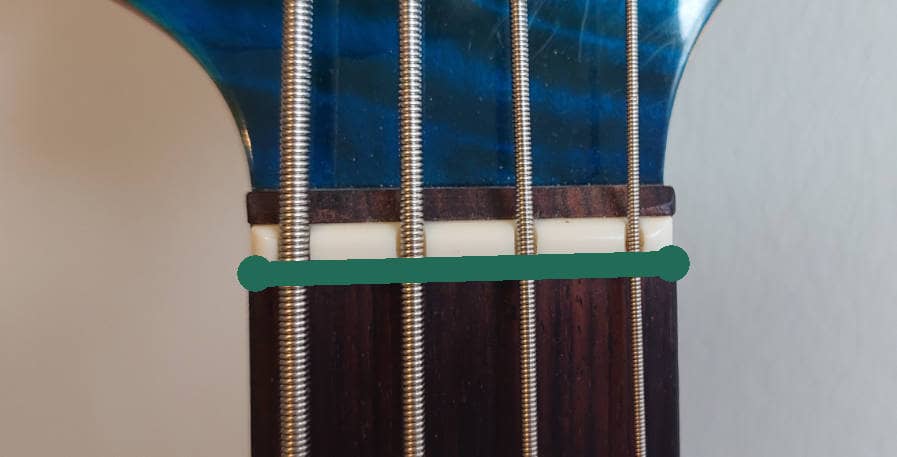
Nut width measures how wide the neck of a bass guitar is where the fretboard meets the headstock. Most 4-string basses have a nut width between 38mm (1.5″) and 43mm (1.7″).
The width of the nut dictates how thick the neck of the bass is at the deepest frets. This metric is also sometimes called zero fret width.
Nut width, as well as nut height, plays a big role in how the instrument feels to play. A narrow nut results in narrow string spacing, which can make the bass less cumbersome to fret and easier to play for bassists with small hands.
For the same reason, this can make it harder to keep strings muted and to fret them cleanly, as it requires more precise playing.
One of the key differences between the Fender Jazz and the Fender Precision bass is their difference in nut width. The jazz bass has a narrow 38mm nut width (1.5″). The precision bass has a wide 43mm nut width (1.7″).
Some manufacturers will also list the width of the fretboard at the 12th fret, or “12th fret width”. This is used to give an idea of how much the neck expands in size at the lower frets.
Radius
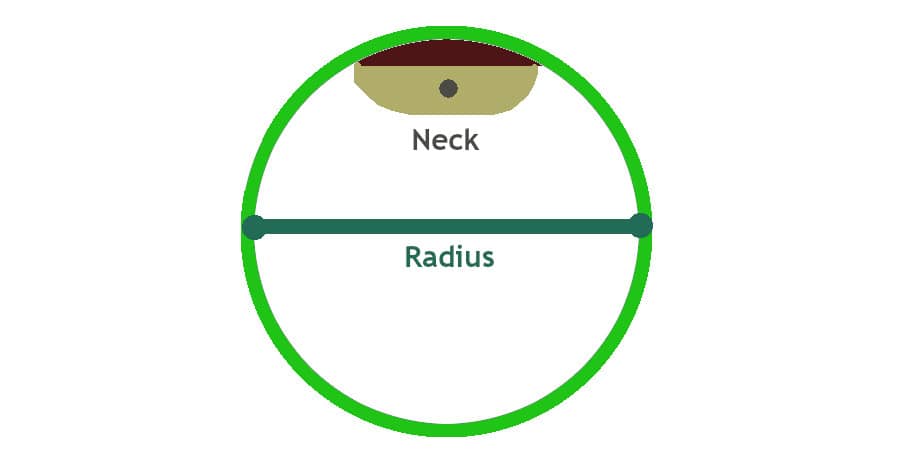
The radius of a bass guitar measures how wide the fretboard arches around itself. Most bass guitars have a radius of 7.5″ to 20″ (19cm to 51cm).
Close to half of the members of the Talkbass forums preferred a wide radius of 12+. Out of those who opted for a bigger radius, many preferred one in the 18-20 range. More than 40% of bassists preferred a smaller radius of either 7.5 or 9.5.
Personally, I`ve never felt that the radius of any bass I`ve tried has made a huge difference. However, I`ve met others who have felt that it has completely shaped the playability of their bass.
Thus, it is subjective how much of a difference radius will make for you as a bass player.
However, it is beneficial to know that when you find a fretboard cumbersome or smooth to play, this could in large part be because of its radius. In this case, it is a best practice to seek out or avoid basses with a similar radius in the future.
Weight
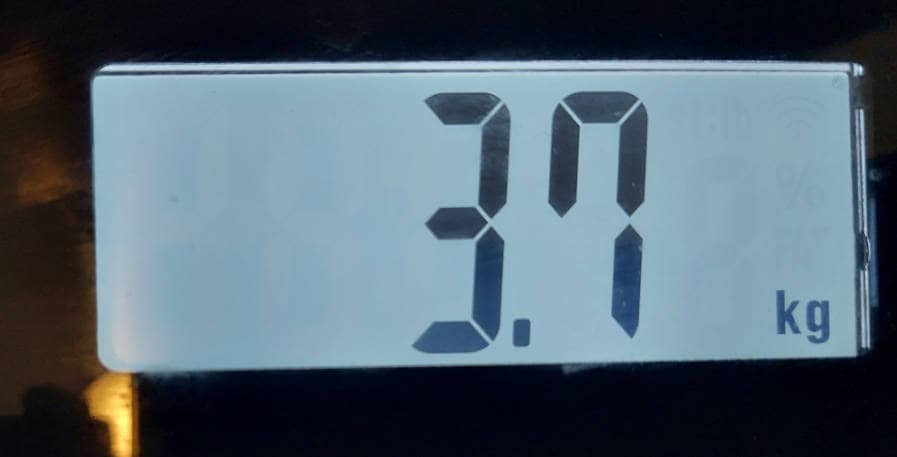
Long-scale 4-string bass guitars generally weigh between 6 and 9lb (2.7kg to 4.1kg).
The bass guitar is a relatively heavy instrument. This will become particularly noticeable when you play it standing up for longer periods of time.
Thus, a heavy bass can be uncomfortable to play for young musicians, beginners, or bass players suffering from back pain. On the other hand, others will find heavier basses sturdier, more comfortable, and more well-balanced to play.
The weight of a bass is relative to its other dimensions. However, wood type, build quality, and shape can have a big impact on the overall weight of the bass.
For example, Hofner`s violin bass which was famously played by Paul McCartney weighs 4.6lb (2.1kg).
On the other hand, Yamaha`s TRBX204 weighs 11.1lb (5kg).
Thus, it is beneficial to treat weight as its own metric, as similar basses can differ a lot in how much they weigh.
Neck thickness
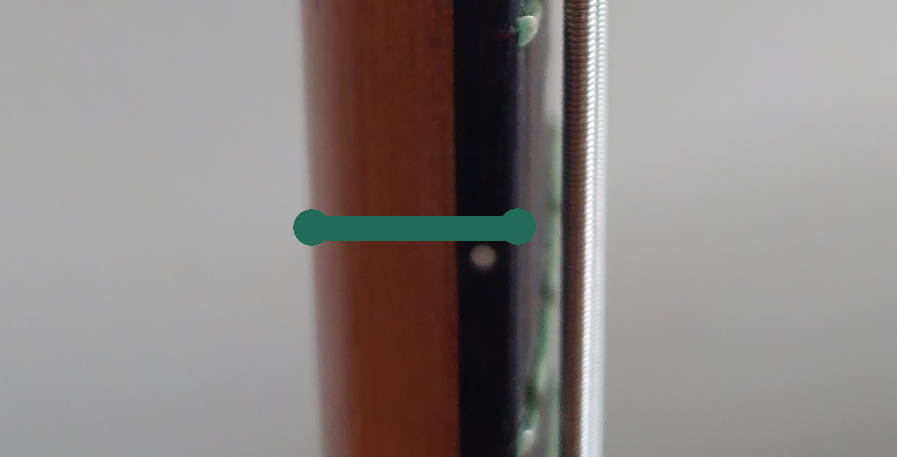
Neck thickness is measured from the surface area of the fingerboard (discounting the frets), and to the furthest point at the back of the neck. As bass necks expand in thickness at lower frets, neck thickness is generally measured both at the 1st and 12th fret.
At the first fret, most bass guitars fall in the 0.75″ to 0.95″ (19mm to 24mm) range. At the twelfth fret, necks tend to fall in the 0.82″ to 1.05″ (21mm to 27mm) range.
Younger bassists and bass players with small hands generally prefer bass guitars with thinner necks. This is because a thick neck can make it cumbersome to grip the instrument, and reach notes properly.
For the same reason, some bassists with bigger hands prefer thicker necks, as it makes the neck more natural to grip. For them, thin necks can also result in awkward hand positions and a sense that your hands don`t fit the instrument.
However, while physiology and hand size play a role, they don`t solely dictate what type of neck you will prefer. Some bassists prefer necks that would commonly be considered “too small” or “too big” for them, either due to comfort or because they have grown used to it.
I have average-sized adult male hands, and I prefer thin necks. I`ve always felt that thin necks make it easier to play smoothly and fast, whereas thick necks make it feel like I have to do extra work.
Conclusion
There is a good reason scale length is the first metric people mention when talking about bass dimensions. This is because it gives you a good idea of how the bass will fit your physiology and style. It also gives a good general idea of its overall length.
However, there are many other dimensions of a bass guitar that impact whether it will suit you. Width rarely makes a major difference, but depth can have an impact on how comfortable and heavy the instrument feels.
Then there are the less obvious dimensions that can make or break how a bass feels to play. If the neck is too thick for you it could feel difficult to play, and if it is too thin it could feel uncomfortable. The same goes for nut width, and it is a big reason 5 and 6-strings can be more demanding for bassists that are still growing.
If the radius is too wide or narrow, you could find fretting notes unnatural, without being able to clearly pinpoint why. Most importantly, the weight of a bass guitar can prevent you from comfortably being able to play it through an entire rehearsal or live show.
Thus, when you find a bass guitar uncomfortable or comfortable to play, try to look at these metrics and consider how they impact your experience of the instrument. While it can be a lot to take in at first, it will ultimately lead you towards finding your dream bass.

